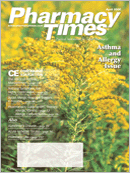A Pharmacist's Guide to OTC Therapy: Ophthalmic Preparations for Treating Allergic Conjunctivitis
Allergic conjunctivitis, also sometimes referred to as ocular allergy, is an inflammation of the conjunctiva that is caused by an allergic reaction. Although allergic conjunctivitis is not contagious, it can be bothersome for those who suffer from some degree of this condition?about 20% of the population. Individuals with ocular allergy often report problems with seasonal allergic rhinitis. Allergic conjunctivitis often is characterized by the following symptoms in both eyes1:
- Redness of the conjunctiva
- Increased tearing
- Itchiness
- Burning sensation
- Blurred vision due to the increase in tearing
Triggers
Allergic conjunctivitis is most commonly triggered by pollen, pet dander, dust, perfume, and cigarette smoke.
Treatment
A variety of products are available to treat the symptoms associated with allergic conjunctivitis. Typically, the use of artificial tear products is the first line of treatment. If symptoms persist, however, the utilization of other nonprescription ophthalmic products?such as decongestant and/or antihistamine ocular drops?may be needed, if deemed appropriate. These preparations are available as a single entity or as a combination of the 2 drug classes (Table).
Decongestants
Available ophthalmic decongestants include phenylephrine, naphazoline, oxymetazoline, and tetrahydrolozine. Individuals should be informed that overuse of ophthalmic decongestants can lead to rebound congestion of the conjunctiva. Patients with narrow anterior chamber angles or narrow-angle glaucoma should not use these products.1
Antihistamines
Pheniramine maleate is the antihistamine agent available in nonprescription ophthalmic preparations. The most common adverse reactions associated with its use include stinging, burning, and discomfort upon instillation.
Role of the Pharmacist
Prior to suggesting any OTC ophthalmic products, pharmacists should thoroughly assess the nature and extent of patients' ophthalmic problems and recommend that they seek medical care when needed. Patients also should be advised not to exceed the recommended dosages of these products and to immediately seek medical attention if symptoms persist after a few days.
Although adverse effects are considered to be rare, patients still should be informed of possible effects associated with the use of these preparations. Patients who wear contact lenses should be advised not to wear them until the condition is resolved. Patients should be screened for possible contraindications as well. It is imperative that patients receive thorough counseling on the proper use of these products and that these products be used according to the manufacturers' recommendations.
Ms. Terrie is a clinical pharmacy writer based in Haymarket, Va.
For a list of references, send a stamped, self-addressed envelope to: References Department, Attn. A. Stahl, Pharmacy Times, 241 Forsgate Drive, Jamesburg, NJ 08831; or send an e-mail request to: astahl@ascendmedia.com.

